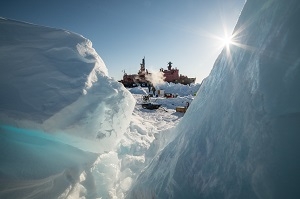The Kara-Winter-2014 Ice Expedition Has Finished Field Studies in the Arctic Ocean

 The Kara-Winter-2014 Ice Expedition organized by the Arctic Research and Design Center (a joint venture of Rosneft and ExxonMobil) with expert support from the Arctic and Antarctic Research Institute Federal State Budget Institution was successfully finished. It has become the largest expedition in the Arctic Ocean since the USSR collapse. Within 63 days scientists have been studying least developed areas of three northern seas: the Laptev, Kara, and East-Siberian Seas on board the Yamal Ice-Breaker. The works have been also carried out off the coast of Novaya Zemlya, Severnaya Zemlya archipelagoes, and De Long Islands.
The Kara-Winter-2014 Ice Expedition organized by the Arctic Research and Design Center (a joint venture of Rosneft and ExxonMobil) with expert support from the Arctic and Antarctic Research Institute Federal State Budget Institution was successfully finished. It has become the largest expedition in the Arctic Ocean since the USSR collapse. Within 63 days scientists have been studying least developed areas of three northern seas: the Laptev, Kara, and East-Siberian Seas on board the Yamal Ice-Breaker. The works have been also carried out off the coast of Novaya Zemlya, Severnaya Zemlya archipelagoes, and De Long Islands.
There have been carried out ice and meteorological measurements at 35 stations. 40 drifting buoys have been installed at ice fields and icebergs, the westernmost buoy has been installed off the coast of Novaya Zemlya, and the easternmost along Bennett Island in the East Siberian Sea. These buoys allow constant monitoring of ice features coordinates and to determine driftage of their trajectory.
There have been never carried out so large-scale studies in the arctic seas before. This was the first time, when physical and chemical properties and morphometric parameters of icebergs and hummocks of the Laptev Sea were studied, as well as water mass distribution, stream, and variability of temperature. Iceberg drift along Severnaya Zemlya archipelago was studied for the first time. Most of the icebergs (about two thousand) have been recorded along the eastern coast of the archipelago. Along Matusevich inlet there has been discovered a giant iceberg of 3x1 km of linear dimensions.
Remote-piloted vehicles and helicopter KA-32 were involved in the exploration of ice cover, and unique remotely operated vehicles Gnom with depth of submersion of up to 100 meters for the exploration of sea floor. The participants of Ice Expedition studied the gouging traces at the bottom of the sea, which can show drift directions and maximum keels of hummocks.
During the Ice Expedition, scientists were observing oceanic mammals and birds in order to evaluate potential impact of oil production to arctic nature, and to develop environmental regulations for shelf development.
On the basis of the received data there will be constructed 3D models of ice features. This will allow Rosneft to determine safe points for exploration works, to design drilling platforms and other constructions for oil production, to choose routes for transportation of hydrocarbons and possible routes of offshore pipelines. The expedition is not only about pragmatic interests of the Company. In the scientific community, data received in the course of this expedition are considered as a breakthrough in studying the Arctic.
Notes for Editors:
Rosneft holds 46 licenses for offshore oil and gas exploration and production in the Russian Federation and is the largest Russian offshore subsoil user, its resources amounting to 318 boe. The Russian Arctic sedimentation basins are comparable with the world’s largest oil and gas regions in their total oil and gas potential.
In view of the hard working conditions in the northern seas, Rosneft intends to use unique technologies and equipment, which will give a powerful boost to development of Russian industry. The Company investments in the Arctic shelf program will amount to 400 billion dollars within 20 years, and multiplicative effect will exceed this amount more than 7 times.
Rosneft has already conducted a number of research expeditions in its offshore Arctic license areas. In August 2013 alone, those involved 13 various class vessels, 3 aircraft, a number of unmanned drones, subsea and above-water recording stations, satellite observation systems, ROVs. Leading Russian and international research and design organizations participated in the studies.
Rosneft Information Division
June 9, 2014